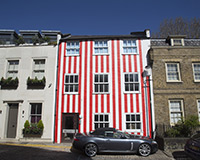 A woman who has been accused of having her multi-million pound Kensington townhouse painted in red and white stripes in protest over a planning dispute with the local authority today lost a High Court challenge to its policy on basement developments.
A woman who has been accused of having her multi-million pound Kensington townhouse painted in red and white stripes in protest over a planning dispute with the local authority today lost a High Court challenge to its policy on basement developments.
Mrs Justice Lang at the High Court in London rejected a lawsuit brought by Zipporah Lisle-Mainwaring and specialist contractors Basement Force that seeks to quash a recent revision to the Royal borough of Kensington and Chelsea’s planning rules designed to place tighter controls on underground extensions.
In today’s ruling Lang J said that the borough hadn’t made an error in law when it made changes to the policy and it had made a “reasonable” decision supported by “relevant considerations”.
The case highlights a conflict that is taking place in exclusive areas across the capital between wealthy London homeowners who seek to build underground to create more living space, and councils who are worried about the effect this will have on neighbours.
The policy, intended to protect residential amenity in the borough from the noise, disturbance and additional traffic movements associated with basement development, and to achieve only the highest standard and quality of development, limits such extensions to a single-storey and restricts them to 50% of any garden, with exceptions possible only for “large comprehensively planned sites”.
However, at a three-day hearing earlier this month, lawyers for Lisle-Mainwaring and Basement Force said that the policy was counterproductive and likely to lead to precisely the form of harm it seeks to prevent.
They cite the availability of permitted development rights under the Town and Country Planning (general Permitted Development) Order 2015 (“the GPDO”) that apply to basement development as long as it does not extend beyond any relevant wall of the dwellinghouse concerned, or come within a prohibited distance of a relevant cartilage boundary.
They argued that the GPDO imposes no limit on the depth of any basement constructed, and that the potential impacts of construction under those rights on the amenity of adjoining properties cannot be controlled by planning condition. As a result, they say that the new basements policy is likely to result in landowners seeking to construct larger basements that fall under permitted development rights.
But Lang J made it clear in her judgment that these criticisms of the policy were not sufficient to allow her to make changes to Kensington & Chelsea’s decision as they didn’t amount to an error in law.
“Parliament has entrusted the responsibility for the preparation of development plan documents to a local planning authority,” she wrote in the judgment. This “requires it to exercise its judgment on the development and use of land within their area, within the statutory framework.”
“The role of the court is a much more limited one of statutory review, intervening only when an error of law is established, and not conducting a review of the merits of the planning authority’s development plan documents,” she wrote.
She said that the claimants should pay 80% of the council’s legal costs.
Lisle-Mainwaring and anr v Royal Borough of Kensington and Chelsea Planning Court (Lang J) 23 July 2015
Paul Brown QC and Harriet Townsend (instructed by Richard Max & Co) for the claimants.
Timothy Straker QC and Dilpreet K Dhanoa (instructed by the Royal Borough of Kensington & Chelsea Legal Services Department) for the defendant.








